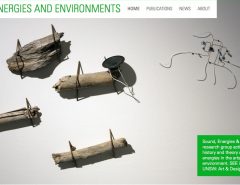The Fragmented Orchestra construct a giant pulsating electronic brain at Ding>>Dong the Liverpool exhibition at the crossroads of art and technology.
The Wire . By David Stubbs
Ding>>Dong: Bleeps, Bangs And Electronic Noises is at FACT Liverpool to 22 February. fact.co.uk
Ding>>Dong is an ongoing sound and audiovisual exhibition in Liverpool which this month will take in a talk by The Wire’s Simon Reynolds entitled “Theory Of The Hardcore Continuum”, and a new live piece, Coda, by Liverpool resident Philip Jeck. Ding>>Dong opened last December at FACT (Foundation for Art and Creative Technology), which is the sort of enviable social vortex for the arts-minded which a larger metropolis like London, in its sheer diffuseness, lacks. The Liverpool post-punk scene benefited from the fact that most of its creative players had only one club, Eric’s, to go to – a place where they could rub shoulders and create friction. The spirit of that incestuousness lives on at these galleries. Take Energy Suite, for example, conceived by Factory Records designer and artist Peter Saville, Andy McCluskey of Orchestral Manoeuvres In The Dark and Hambi Haralambous, who headed the group Hambi & The Dance. It’s a gallery juxtaposition of music and images of all the great natural and industrial forces that still go into power generation, from giant cooling towers acting as screens to the shadows of the clouds they are belching, to banks of cloud rolling slowly over Welsh mountainscapes, precipitating into the glittering rivers snaking through the valleys. It’s essentially a Kraftwerk-inspired hymn of praise to the landscape of the North West of England. McCluskey’s score is underpinned by pipeworkings of hiss and drone, but the somewhat tonal, mock-symphonic airs to which he ascends are irksome in their certainty. Fortunately, the sheer strength of the moving images pushes the music into the background. These images, shot against bright blue skies, scotch every tedious, received notion of the industrial North as one grey, ugly slagheap. Believe it or not, there are few more arresting manmade sights than a gasworks plant, with all their tubular, metallic arrangements, like some gigantic 3D sculpture. The natural and manmade forces represented in Energy Suite are still an active, forceful part of the landscape. We are not postindustrial yet.Next, The Fragmented Orchestra, comprising Jane Grant, John Matthias and Nick Ryan. Their installation consists of 24 speakers suspended in a darkened room, each transmitting live sounds picked up by microphones and transmitted via the internet from a variety of locations across the UK – London’s National Portrait Gallery, the Brontë Parsonage Museum in Howarth, from schools, observatories and locations as far afield as Devon and Derby – and sports stadiums. Says Matthias: “We wanted to choose sites which exhibited rhythms on different timescales. So a football ground is pretty quiet except for a Saturday afternoon every two weeks. The school hall gets loud in the morning and at lunchtime, and the sounds from Brontë Parsonage museum are more elemental – wind, rain.” The arrangement, a sort of ‘neural network’, is meant to mirror the function of the human brain and the way it processes sound. It’s a real-time version of the Neurogranular Sampler, a piece of software which members of The Orchestra developed to simulate the ‘wiring and firing’ which takes place in the cerebral cortex and the complex, rhythmical interrelationships that ensue. “Each site has a neuron to stimulate (it fires when the volume is over a certain level) and then when the neuron fires it also lets a tiny grain of the audio through to its speaker at FACT, while also sending spike signals to all of the other neurons,” says Matthias. “You can therefore hear the neurons communicating with each other – they appear to set each other off across the speaker installation.” At the time of visiting the gallery, noises emerged either in phut-phuts, as if the technology is not quite functioning, or in grand, overwhelming blasts, such as the organ from St Andrew’s church in Fulham Fields, or not at all. There is a mic hooked up at Goodison Park, Everton’s football stadium. Crowds at sports events, although recognisable, behave in a singularly unpredictable way. Was that the appeal? “The analogies between the flow of information across the cortex and the idea of the crowd having multiple parts forming a whole is at the core of the choices for both Everton Football Club and the Millennium Stadium,” says Jane Grant. “Obviously the amplitude will affect the ‘cortex’ as a whole, raising the overall sensitivity of the sound for that time period. But mainly I love the idea of this fluid sound coming from the games being fragmented and overlaid. I guess this will extend all of those minute ripples and changes of sound, pensiveness mixed with expectation. With speech there are gaps and pauses; with thousands of people all shouting and singing in time, you can’t hear the gaps, just a huge wave of sound.” So fitful and sporadic are these sounds that it’s left to chance just how well you’ll be rewarded from your visit here – but there is a strange, radio ham’s delight when, for instance, the sounds of a kid’s party in a London gallery break down the wires, unspoiled even in this era of media supersaturation. Perhaps that’s down to the context of the gallery, with its heightened air of attentiveness.
There are a number of smaller, interactive installations in which nascent technologies are showcased. Fijuu, for example, is a program whereby the user can create improvised sound by manipulating 3D images on a games-style console. Tetsuaki Baba’s The Freqtric Project is an interface device whereby you can turn your own body, and that of others, into a percussive instrument, a drum trigger. All of these are indicative of the societal shift from passive spectatorship to the pseudo-creative, pseudo-active culture of computer games, Rock Star, etc. Sound art is becoming an increasing staple of galleries, as old relationships, assumptions and barriers slowly collapse, as do traditional notions of where sound should be broadcast from, how and by whom. And yet the feeling remains that passivity is not to be given up lightly. Take Ray Lee’s Swarms, three tripods containing speakers hanging just above the entrance to the gallery’s cafe. Storing up digital information, they are set in motion at regular intervals, unleashing a sweet, sonic shower of Ambient electronica that hums volumes about the quiet joy of this location. As an installation, it’s remote, out of touch and beyond the manipulative control of the listener. It’s just there. And there’s still something to be said for all that.




Leave a Reply
Lo siento, debes estar conectado para publicar un comentario.